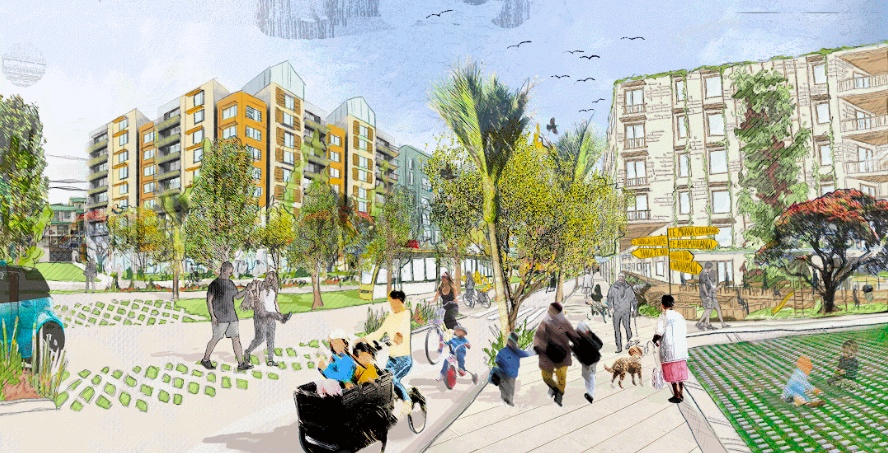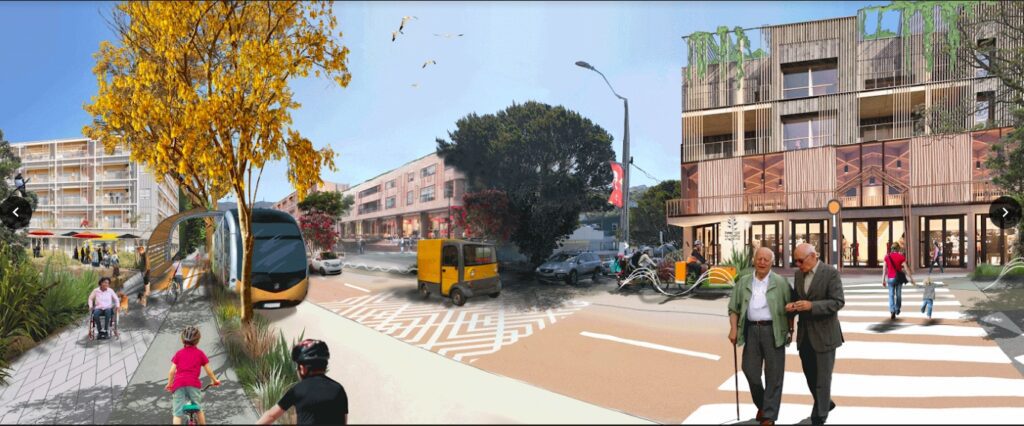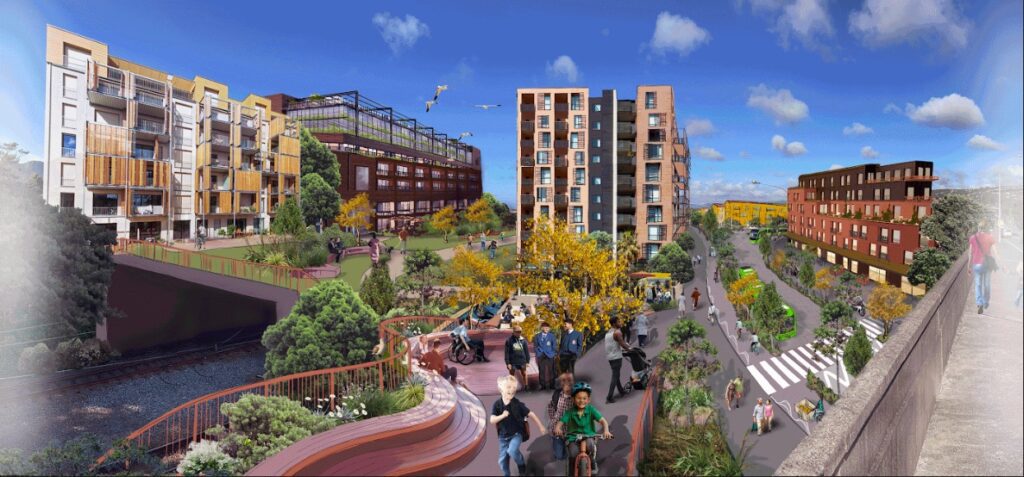
in Mt Cook
It's got the basic recipe...
"Tell us about this Adelaide Road you see..."
Adelaide Road has blossomed from a gritty, industrial area into a liveable neighbourhood with good coffee, cold beer, lively childcare, great gigs and everything else Wellingtonians need. It’s no longer just an arterial road, it’s a place to call home. Light rail and safe bike and scooter paths have opened up people’s world of transport options and most people no longer bother to own a car. The street is safe for children, older people and young families thanks to traffic calming measures and a universal 30kph speed limit. Adelaide Road bustles with locals coming and going, hopping on and off at the light-rail and bus stops, rolling past on their bikes, and strolling the tree-lined footpaths. Even when Wellington’s weather does its thing, Adelaide is still lively with people: footpaths and bike lanes stay clear of flooding, and the short walks to the frequent mass transit stops mean the streets are bright with raincoats. People working from home, new parents and older residents connect and socialise in the cafes, playcentres, grocers, and community gardens dotted throughout the neighbourhood. In the evenings, couples and families head out for an evening stroll through the greener streets, grabbing an ice cream or a hot chocolate and taking in their surroundings and listening to the sounds of laughter, buskers, and birdsong.
- a Mt Cook local, 9th August 2040
Adelaide Rd: a basic quarter-hour paradise in action
This is how the essential recipe of the quarter-hour paradise – even just with a very basic lens of “just be buildable” – makes life better in Mt Cook.
People-friendly streets

The footpaths are lit the entire way along by pedestrian-scale lighting on verandahs and awnings, creating a sense of safety and openness.
Balconies, verandahs and good quality building design help to integrate residential life with the surroundings, and increases safety thanks to lots of eyes on the street.
There is a pocket park in the north-east corner of almost every city block, known as “cuppa ugg boots” for the way they’re typically enjoyed by the neighbours.
The 30kph speed limit for all vehicles helps make the road safe, along with general traffic calming techniques such as different surfaces and tightened corners.
There is no on-street car parking, but speial loading and servicing vehicles can access buildings via heavily calmed side streets and service lanes, and larger vehicles such as recycling trucks have special provision for timed access.
Most buildings have a residents’ car share along with comprehensive ebike and cargo-bike sharing services, as well as parking for private bikes and scooters.
The light rail runs on 3.2-metre green tracks, which cool the street in summer and absorb rain in winter. They’re lined with a generous buffer of native plants on each side, and the first sighting of the summer’s Street Butterfly kicks off a neighbourhood street party
Density done well

The apartment buildings which run along the street are mostly six to eight storeys high, with the ground level dedicated to retail, hospitality, and offices, including boutique medical services which want to be near Wellington Hospital.
Buildings are filled with a wide variety of sizes, from 5 bedroom through to spacious 5- and 6-bedroom homes, featuring a variety of tenures. People from all walks of life, all ages and stages, have stable foundations calling this neighbourhood home.
There are common spaces and shared facilities within the residential buildings, including deck gardens, shared bike and scooter parking, play areas, lounges and games rooms. This encourages neighbours to meet each other and form close relationships.
The buildings are well orientated to make the most of the sun’s free energy and light while also providing shading in the summer with overhangs/shades on windows on the north and western faces to help prevent overheating.
They are well-insulated walls and energy-efficient design such as airtight windows with minimal thermal bridging, which reduces heat loss and condensation.
There is an upgraded pipe network with better capacity for wastewater, and smart retention tanks which intelligently manage peak flows into the pipe system. Smart rainwater tanks self-empty ahead of storms and use captured rain for washing machines and flushing toilets, which combine with the green track and street green to make nuisance flooding a thing of the past.
The rain gardens and living dividers (swales) between the lanes filter runoff from the road. Large native trees and native plantings in the street provide canopy cover and habitat to attract birds, insects and lizards from the Town Belt and Zealandia.
Access to all you need



Adelaide Road provides immediate and easy transport links to anywhere in the city, making commutes and shopping trips a breeze.
Reliable, frequent, efficient electric trams whisk residents to the city centre, the train station, the Newtown shops or the beach in Island Bay.
The 2.1m biking and e-scooter lane has raised separators to keep riders safe, and there is just one 3.5-metre-lane each way for general traffic.
Wellington hospital is just around the corner, and the street-level offices quickly become a hub for expanding medical services.
There are small cafes, eateries, and micropubs along the street with loyal followings of local residents, workers, and even people from beyond Mt Cook.
The options for getting around are so good that the great majority of residents don’t bother to own a car, having a rich life locally plus lots of transport options for going further afield.
More technical information about the buildability
This vision may look comprehensive, but like all the visualisations here, this picture is simply what you get when you apply the most basic quarter-hour paradise recipe to this location.
It’s working much better for people and the taiao, but it’s still a bit beige, it’s unadorned, lacking local flavour or community nuance.
The big missing element: how local people would like to see quarter-hour paradise growing in their neighbourhood.
Let's explore this together!
Over on the Quarter-hour Paradise social media there’s friendly, curious conversation happening.
It’s about how neighbourhoods like Karori can develop their quarter-hour paradise goodness in ways that feel local. In ways that draw out, that build on, that amplify what’s great about the neighbourhood.
It’s a bit of an oasis on social media.
- iI’s a space to bring genuine questions and ideas about what change might mean; about bad and good ways to do intensification, to do street change, and to set up and run our towns.
- There’ll be honest answers, inspiration from our own doorsteps and further afield, and other curious minds from your community – all coming together a spirit of “why not?”, “we got this”, and “yes, and“.
- It’s apolitical (no endorsements or promotions of candidates), and it’s a space for citizen conversation.



